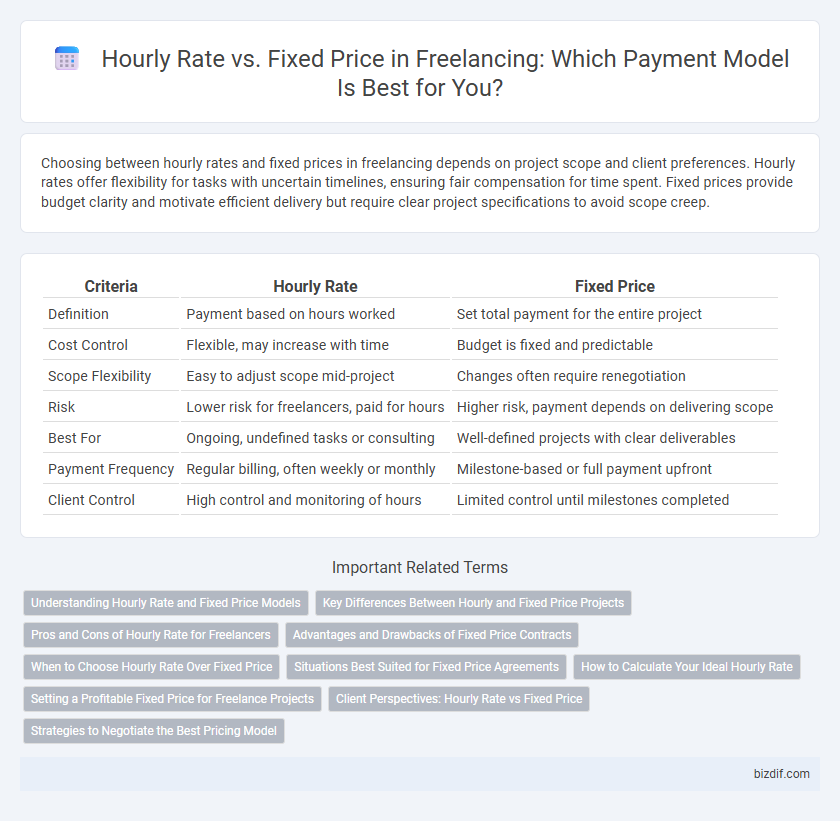Choosing between hourly rates and fixed prices in freelancing depends on project scope and client preferences. Hourly rates offer flexibility for tasks with uncertain timelines, ensuring fair compensation for time spent. Fixed prices provide budget clarity and motivate efficient delivery but require clear project specifications to avoid scope creep.
Table of Comparison
| Criteria | Hourly Rate | Fixed Price |
|---|---|---|
| Definition | Payment based on hours worked | Set total payment for the entire project |
| Cost Control | Flexible, may increase with time | Budget is fixed and predictable |
| Scope Flexibility | Easy to adjust scope mid-project | Changes often require renegotiation |
| Risk | Lower risk for freelancers, paid for hours | Higher risk, payment depends on delivering scope |
| Best For | Ongoing, undefined tasks or consulting | Well-defined projects with clear deliverables |
| Payment Frequency | Regular billing, often weekly or monthly | Milestone-based or full payment upfront |
| Client Control | High control and monitoring of hours | Limited control until milestones completed |
Understanding Hourly Rate and Fixed Price Models
Hourly rate models charge clients based on the actual time spent on tasks, providing flexibility for projects with evolving scopes or uncertain timelines. Fixed price models establish a predetermined fee for complete deliverables, ideal for well-defined projects with clear objectives and deadlines. Choosing between hourly and fixed price depends on project complexity, risk tolerance, and the need for budget predictability in freelancing engagements.
Key Differences Between Hourly and Fixed Price Projects
Hourly rate projects charge clients based on actual work time tracked, allowing flexibility for changing project scopes and tasks. Fixed price projects involve a predetermined budget agreed upon before starting, providing cost predictability but requiring precise project specifications to avoid scope creep. Understanding these differences helps freelancers choose pricing models that align with project complexity, client expectations, and risk tolerance.
Pros and Cons of Hourly Rate for Freelancers
Hourly rate pricing allows freelancers to get paid for all the time invested, ensuring fair compensation for variable workloads and unanticipated revisions. This model offers flexibility, promoting transparency and adaptability during project scope changes, but it can lead to income unpredictability and potential client disputes over hours logged. Freelancers must carefully track time and communicate clearly to avoid misunderstandings and maximize earning potential.
Advantages and Drawbacks of Fixed Price Contracts
Fixed price contracts offer predictability in budgeting and clear deliverables, making them ideal for well-defined projects with stable scopes. However, they may limit flexibility, posing risks for freelancers if project requirements expand or unforeseen challenges arise, potentially leading to undercompensation. Clients benefit from cost certainty, but changes or scope creep can result in disputes or renegotiations, impacting overall project efficiency.
When to Choose Hourly Rate Over Fixed Price
Choosing an hourly rate is ideal when project scope is uncertain, requiring flexibility for evolving tasks and ongoing client collaboration. This approach ensures fair compensation for time spent on complex or iterative assignments where deliverables or timelines cannot be precisely defined in advance. Freelancers benefit from hourly pricing when managing variable workloads or projects that involve frequent changes and client feedback.
Situations Best Suited for Fixed Price Agreements
Fixed price agreements are best suited for projects with well-defined scopes, clear deliverables, and predictable timelines, ensuring budget certainty for clients and streamlined workflow for freelancers. These contracts work effectively when tasks are repetitive or standardized, such as website design, content creation, or software development with specific requirements. Choosing fixed price models minimizes the risk of scope creep and fosters trust by aligning expectations between clients and freelancers from the outset.
How to Calculate Your Ideal Hourly Rate
To calculate your ideal hourly rate in freelancing, start by defining your desired annual income and then divide it by the number of billable hours you expect to work per year, typically factoring in non-billable time such as marketing, administration, and breaks. Consider including business expenses, taxes, and savings to ensure your rate covers all costs and generates profit. Research market rates within your industry and skill level to remain competitive while reflecting your expertise.
Setting a Profitable Fixed Price for Freelance Projects
Setting a profitable fixed price for freelance projects requires accurately estimating the total hours needed and multiplying by a well-researched hourly rate that reflects your expertise and market demand. Consider including a buffer for unexpected revisions or scope changes to protect your income and avoid project losses. Analyzing similar projects on platforms like Upwork or Fiverr helps determine competitive yet fair fixed prices, ensuring profitability while maintaining client satisfaction.
Client Perspectives: Hourly Rate vs Fixed Price
Clients often prefer fixed-price contracts for clear budget control and predictable costs, reducing the risk of unexpected expenses. Hourly rates appeal when project scopes are uncertain or likely to evolve, allowing flexibility and paying only for actual time worked. Understanding these preferences helps freelancers tailor proposals to client priorities, balancing transparency with adaptability.
Strategies to Negotiate the Best Pricing Model
Freelancers should assess project scope and client preferences to determine whether an hourly rate or fixed price model maximizes value and minimizes risk. Employing clear milestones and transparent communication establishes trust, enabling negotiation for rates aligned with skill level and market demand. Leveraging portfolio evidence and industry benchmarks empowers freelancers to justify pricing structures tailored to project complexity and anticipated revisions.
Hourly Rate vs Fixed Price Infographic

 bizdif.com
bizdif.com